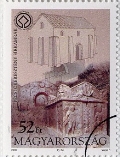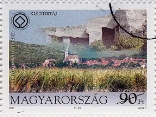WORLD HERITAGE SITES IN HUNGARY III
Date of issue: 16 March 2006
It is important for every nation to nurture its own culture, history and traditions. Besides assets of local value, there are some of import for the whole of mankind. To protect these, UNESCO created the World Heritage Commission and adopted the “Convention concerning the Protection of World Cultural and Natural Heritage” in 1972.
Early Christian necropolis in Pécs (2000)

The 4th-century early Christian cemetery of the Roman town of Sopiane (modern day Pécs) was placed on the list of cultural treasures by the World Heritage Commission in 2000 with the justification that the early Christian sepulchral art and architecture of the northern and western Roman provinces is fully and excep-tionally well illustrated by the cemetery’s structures and frescoes. The underground burial chambers and memorial chapels bear witness to the strength and faith of the Christian communities of Late Roman Europe, and also show the roots of a culture and civilisation that has survived up to the present day and continues to influence it.
Fertő-Neusiedler Lake cultural landscape (2001)

Lake Fertő was declared a biosphere reserve by UNESCO in 1979
due to its unique natural values. The World Heritage Commission placed
Fertő-Neusiedler Lake and its surrounding area on the list of World
Heri-tage as a cultural landscape in 2001 based on a Hungarian-Austrian
proposal drawn up with exemplary co-operation on joint guidelines. The
lake area has been a meeting place for different cultures for eight
millen-nia. This unique cultural landscape is the result of an
evolutionary symbiosis between human activity and the physical
environment. Besides its natural values, the remarkable rural
architecture of the villages and several 18th- and 19th-century palaces
add considerable cultural interest to the area. Three quarters of the
lake is in Austria, yet the region has a physical unity little affected
by geographical division.
The World Heritage emblem, symbolising the
close connection between and mutual impact of cultural and natural
assets, features on the stamps. The central square represents a form
created by human hand, while the circle stands for nature and
naturalness. Both forms are integrally linked, starting from and
returning to each other. The emblem is round like the earth and the
circle is a symbol of embracing protection.
There is a first day
cover for each denomination of the set of stamps, showing a view of the
respective areas. The design of the special postmark shows a graphic
composition evoking the ambience of both sites.
Source:
www.unesco.hu *
www.vilagorokseg.hu
Order code:
2006030050211 (stamp)
2006030060012 (FDC, Pécs Early Christian necropolis)
2006030060112 (FDC, Fertő-Neusiedler Lake cultural landscape)
Date of issue: 16 March 2006
Face value: HUF 52, 90
Number of copies: 400.000
Printing method: offset
Perforated size: 45,00 x 33,33 mm (50 stamps per sheet)
Printed by Pénzegynyomda Zrt.
Designed by Pál Varga

